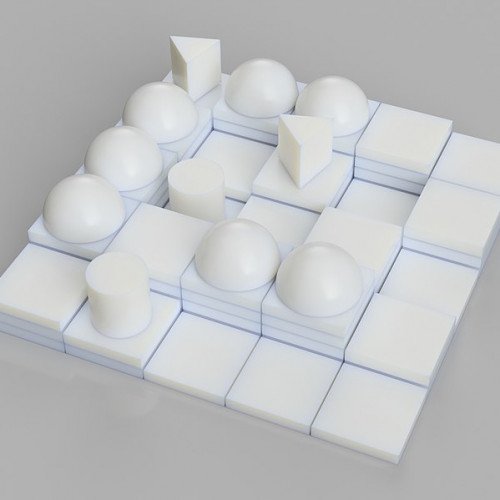SANTORINI VS TAK

SANTORINI
Santorini is an abstract strategy board game for 2-4 players designed and released in 2004 by Gordon Hamilton and republished via Kickstarter in 2016 by Roxley Games. Inspired by the architecture of cliffside villages on Santorini Island in Greece, and primarily designed for two players, the game is played on a grid where each turn players build a town by placing building pieces up to three levels high. To win the game, players must move one of their two characters to the third level of the town. Each turn of play involves moving one of your two pieces around a 5-by-5 grid each turn and then placing a tile adjacent to the moved piece, building up that spot of the board. On subsequent turns, pieces may be moved onto one of these built-up tiles, but only one level up at a time. Pieces may also be moved down any number of levels. Players may also place a special dome tile on top of a three-level building, which prevents a player from moving onto that spot for the remainder of the game. The primary winning condition is to get one of your pieces onto the third level, though players may also win if their opponent is unable to make a move. The Roxley Games version of Santorini introduced a god powers variant, which gives each player a unique way to break the rules. After being directly released and sold by Hamilton in 2004, Roxley Games ran a Kickstarter campaign during March-April 2016, drawing over 7,100 backers and raising over C$700,000, the most successful Kickstarter campaign ever based in Alberta. While the original release used plain white blocks as components, the Roxley version featured an enhanced cartoon-like look to the game, which Hamilton credits for success of the Kickstarter campaign. The game was released in retail outlets in January 2017.
Statistics for this Xoptio

TAK
Tak is a two-player abstract strategy game designed by James Ernest and Patrick Rothfuss and published by Cheapass Games in 2016. The goal of Tak is to be the first to connect two opposite edges of the board with pieces called "stones", and create a road. To accomplish this, players take turns placing their own stones and building a road while blocking and capturing their opponent's stones to hinder their efforts at the same. A player "captures" a stone by stacking one of their pieces on top of the opponent's. These stacks can then be moved as a whole or broken up and moved across several spaces on the board. The vertical stacking and unstacking of stones gives a three dimensional element to the game play. A player may move a single piece or a stack of pieces they control. A stack is made when a player moves a stone on top of another flat stone of any color. The stone on top of a stack determines which player has control of that entire stack. All stones move orthogonally in a straight line on the board. There is no diagonal movement. A player can also move a whole stack in addition to single stones. A stack can be moved like a single stone, moved in its entirety one space orthogonally (North, South, East, or West), or it can move several spaces orthogonally by breaking the stack and placing one or more flat stones onto the squares being moved onto. The player can leave any number of stones, including zero, on the starting space, but must place at least one piece for each subsequent move. There is no height limit for stacks, but the amount of stones a player can remove from the stack and move is set by the "carry limit" of the board. The carry limit of the board is determined by the dimensions of the board. For example, if the stack was on a 5x5 board, the carry limit of the stack would be five. Because standing stones and capstones can't be stacked upon, there are no stacks with these pieces at the bottom or in the middle of the stack. Both of these stones however can be moved onto other flat stones to form a stack with them as the head. A capstone may "flatten" a standing stone and use it to form a stack with the capstone as its head, but it must do so alone. For example, a stack with a capstone cannot flatten a standing stone by moving as a stack onto the standing stone, but a stack can be used to move a capstone across the board so that the capstone alone moves to flatten the standing stone as the final movement.